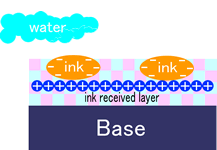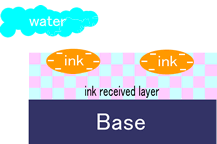| Until recent years, the storage stability
of inkjet papers used for drop-on-demand printing
was not a priority. However, along with an
increase in the use of inkjet prints for graphic
design and output of photographs using digital
cameras, inkjet print storage stability has
become a requirement. Various technologies
are used to improve the storage stability
of inkjet papers.
Explanations of items listed below are
as follows:
1) Water-fastness
2) Light-fastness
3) Change in color
4) Pigment-based inks
Most inkjet inks are water-soluble, and
therefore, if printed materials become wet,
water-soluble inks are easily redissolved
and the image may fade. In a high-humidity
environment, inks are also redissolved and
phenomena such as image running are caused.
Various measures for improvement are being
implemented to prevent ink dissolution.
One commonly-used method is the electrostatic
method. Generally, inks are negatively charged.
In the electrostatic method, by applying
positive charge to a sheet of paper, negatively
charged ink adheres to the paper by electrostatic
forces. (See the figure below.)
 |
 |
Ultraviolet radiation and ozone cause fading
in the colors of inkjet printed materials,
and further improvements in inks have been
required. The quality of inkjet papers,
however, is improving. In recent years,
inkjet printed materials have been developed
that can be stored for several years indoors
assuming the best combination of ink and
paper. Color fading is considered to occur
due to decomposition of pigments by active
oxygen generated by ultraviolet light or
ozone. Improvements are being made using
light stabilizers, antioxidants, and other
methods (see the figure below).
The color of inkjet papers can change during
storage. There are several types of such
"yellowing."
| 1. Yellowing
caused by storage in a file |
| Materials of clear files contain plenty
of antioxidants to prevent discoloration
and deterioration by oxidization. Antioxidants
contained in the film are diffused as
vapor, although they are small in quantity.
When inkjet papers are kept in a clear
file, antioxidants diffused from the
clear file reach the surface of the
inkjet papers. As the ink receptor layer
of an inkjet paper consists of fine
particles, it has a large porous surface
area that easily absorbs chemical compounds.
The antioxidants absorbed change the
color of the paper to yellow through
air oxidation. |
| 2. Yellowing
caused by sunlight |
| Inkjet papers contain fluorescent
whiteners and brightening agents to
increase whiteness. Yellowing of inkjet
papers due to sunlight is a phenomenon
caused by the destruction of fluorescent
whiteners and brightening agents subjected
to light. |
| 3. Yellowing
caused by heat and humidity |
| The yellowing of inkjet papers can
occur when they are left in an environment
with a temperature of 50 degrees Celsius
and humidity of 81%, for example. This
phenomenon is caused by multiple factors
such as destruction of fluorescent whiteners
due to high temperature and humidity,
similar to yellowing due to sunlight,
and discoloration by easily oxidizable
substances in the environment being
absorbed by the surface of the inkjet
paper. |
| 4. Yellowing
due to tape |
| Tape consists of a thin plastic film
and glue, which generally contain antioxidants.
Yellowing due to tape is caused by the
same mechanism as yellowing due to storage
in a file. |
| 5. Yellowing
due to rubber bands or rubber rolls |
Rubber bands and rubber rolls contain
antioxidants to prevent them from hardening
during storage. Yellowing is caused
by the same mechanism as yellowing due
to storage in a file.
Change in color of inkjet papers is
greatly affected by oxygen. The most
important thing is to store inkjet papers
in a sealed or semi-sealed environment.
|
Inks for inkjet printers can be roughly
classified into two types: dye-based inks
and pigment-based inks (click here for details
of ink types). In terms of the storage stability
of printed materials, pigment-based inks
are recommended. Pigments (generally referring
to non-soluble colorants) were used in ancient
wall paintings because of their excellent
light- and water-fastness. Pigment-based
inks created by dispersing pigments into
the vehicle also have excellent light- and
water-fastness. Pigment-based inks, generally
used for large inkjet printers, have not
been employed for A-4 size printers for
consumer use.
|